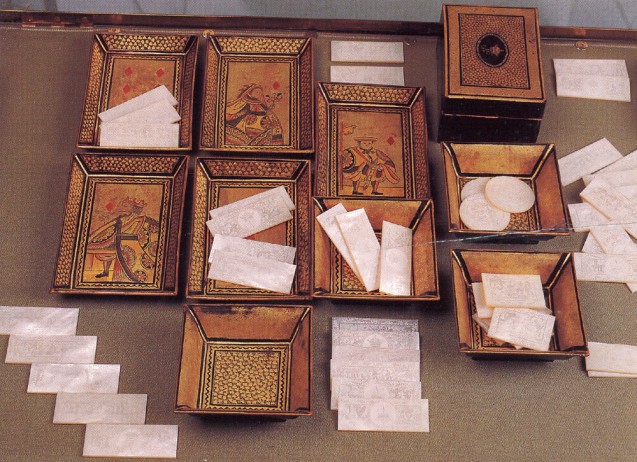This deluxe set for use with the card game L'Hombre has been identified as the “set of ivory counters and box, […] of Chinese manufacture”, referred to by Napoleon's doctor on St Helena, Barry O'Meara, in his famous volume of conversations with Napoleon, A voice from St. Helena, and apparently given to the emperor on 9 July, 1817. According to the Irish doctor, the set had been made by the British Lord Elphinstone and was sent to the emperor because the latter had saved the Lord's brother from death the day before Waterloo.
The Jeu de l'Hombre, known in English as Lhomber, is a card game for three players, usually one man (L'Hombre) against two women, and is in fact the ancestor of Contract Bridge. It was invented in Spain in the 17th century (hence the name L'Hombre) and by the 18th century had become exceedingly popular and prestigious. Full details on this exceedingly complex game (it is still played in Denmark) can be found here (external link).
The ensemble here comprises a container, four boxes, twelve small trays (six rectangular and six square) all in lacquer, and 120 chips and 'fiches' made out of mother of pearl (and not ivory as noted by O'Meara). The playing cards are no longer present. The chips and 'fiches' are chased with scenes of everyday life and decorative elements derived from vegetation and the animal kingdom. In the centre of one side of each piece there is a roundel with a large letter N in it topped with an imperial crown. The boxes, trays, chips and 'fiches' are ingeniously made so that they fit perfectly inside the container. During the games, the boxes and trays would be used for holding the talon (the cards not dealt), the discards and the tricks won. Each player was given twenty circular counters or chips and nine 'fiches' (worth twenty chips) with which to bet.
According to O'Meara, Napoleon “greatly admired the articles”, which also included “a superb set of chessmen and table, two magnificent carved ivory work-baskets” and “he signified his intention to send the work-baskets to the Empress Marie Louise, the box of counters to his mother, the chessmen and superb table to his son.” Whilst we know that O'Meara visited Madame Mère in Rome in December 1819, it is not clear when the set reached the Emperor's mother – Giulia Gorgone in her RNR article of 2002*, thought that it probably occurred after Napoleon's death. That being said, the set reappeared in 1832 in Rome. On 21 July 1832, Count Anton Prokesch-Osten, a close friend of Napoleon's son in Vienna, was visiting the Empress's mother, and she entrusted it to him along with a box containing some of Napoleon's hair, instructing him to transport them to Napoleon's son, the Duke of Reichstadt. The set was never to reach the young Duke, who died in Vienna the following day, and the pieces remained in the Prokesch-Osten family until 1934 when they were bought by Benito Mussolini and destined for the Museo Napoleonico and its new gallery dedicated entirely to Napoleon's son.
Giulia Gorgone, (tr. & ed. P.H. and I.D.)
* Giulia Gorgone, “Da Sant'Elena a Roma: storia di un jeu de l'hombre”, RNR Rivista Napoleonica, 2/2001, “Gioco, società in Europa e in Italia fra Sette et Ottocento”, issue edited by Paola Bianchi and Andrea Merlotti, pp. 217-221.
With the kind permission and participation of the Museo Napoleonico
Appendix
The 'Napoleonic' Elphinstones and St Helena
Lady Malcolm, wife of Rear Admiral Sir Pulteney Malcolm, commander of British naval forces in the South Atlantic, is known for her diary regarding Napoleon on St Helena. Her maiden-name was Elphinstone (she was related to the Scottish noble family), and she was the sister of James and John Elphinstone, the former a captain in the Hussards and the latter a director of the East India Company. Uncle of all three siblings was Admiral Lord Keith, commander of the British Channel Fleet. The story goes that James was wounded at Gemappes, the day before Waterloo. While out scouting the land, Napoleon apparently happened upon him and ordered that he be cared for. Out of gratitude, his brother John (then diplomat in Bombay) had the objects above made and sent to St Helena. Unfortunately, Lady Malcolm's diary ends with an entry for 3 July, 1817, so no mention is made of the arrival of the gifts.
Peter Hicks
Sources: Jacques Macé, Dictionnaire historique de Sainte-Hélène, Tallandier 2004, s.v., ‘Elphinstone, James et John' and ‘Malcolm, lady Clementine, née Elphinstone', p. 206, 303-4.
See also Arnold Chaplin, A St Helena Who's Who, London: Arthur L. Humphreys, 2nd edition, 1919, s.v., 'Malclom, Lady Clementina', p. 99.
May 2011
Deluxe accoutrements for the card game, L’Hombre
Artist(s) : CHINESE MANUFACTURE

- Date :
- First half of 19th century
- Technique :
- Lacquer and mother of pearl
- Dimensions :
- H = (Box) 9 cm, L = 38.2 cm, P = 31 cm
- Place held :
- Museo Napoleonico, Rome (inv MN 637)
- Photo credit :
- © Archivo Fotografico del Museo Napoleonico

